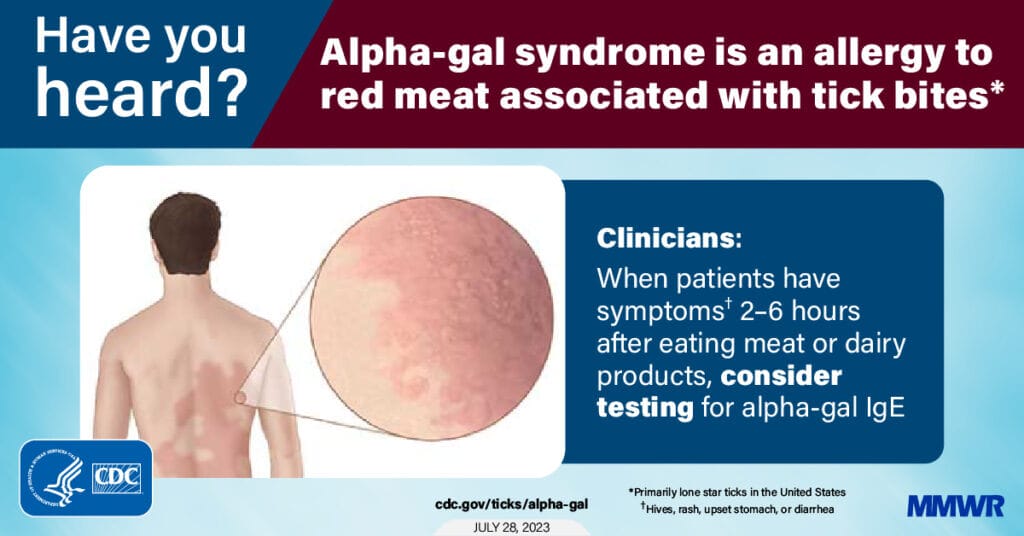
Alpha-gal syndrome, the tick bite-related food allergy, is on the rise. New U.S. health data shows the condition may affect as many as 450,000 Americans.
Yet a related survey of U.S. health-care providers shows that 42 percent are not even aware of alpha-gal allergy. Another 35 percent had heard of it, but were “not too confident” in their ability to diagnose and to help patients manage alpha-gal syndrome (or AGS).
The Centers for Disease Control and Prevention released two reports on AGS on July 27, 2023. One provides the prevalence estimate and data on geographic locations of the condition, sometimes called “red meat allergy”.
The other report provides findings of a nationwide online survey of 1,500 primary care doctors, pediatricians, physician assistants and nurse practitioners. Only 5 percent of health-care providers surveyed (74 providers) felt “very confident” in their ability to diagnose alpha-gal allergy.
This syndrome leads to often severe reactions to red meat, and sometimes related mammalian products, from cow’s milk to pills and cosmetics.
Two-thirds of the health-care providers surveyed indicated a need for guidelines for the diagnosis and management of AGS.
The CDC’s prevalence report says researchers documented more than 110,000 suspected cases of AGS between 2010 and 2022, based on commercial lab testing. The number of positive tests increased annually, from about 13,000 in 2017 to almost 19,000 in 2021.
But given the lack of physicians aware of the condition and ordering tests for the allergy, the researchers estimate the true prevalence of alpha-gal allergy is far higher. Factoring in these gaps, they estimate that up to 450,000 Americans have alpha-gal allergy.
Lack of Testing an Issue
An AGS diagnosis requires a health-care provider examination, discussion of symptoms, as well as a positive IgE antibody test to alpha-gal. The CDC researchers say that many who should be tested for an alpha-gal allergy are simply not getting tested.

The researchers find there are especially barriers to testing in population groups with less education and access to specialists.
“The burden of alpha-gal syndrome in the United States could be substantial given the large percentage of cases suspected to go undiagnosed due to non-specific and inconsistent symptoms, challenges seeking healthcare and lack of physician awareness,” said Dr. Johanna Salzer. The senior author on both reports, Salzer is a CDC epidemiologist who specializes in tick-related diseases.
She urges people who may have developed AGS following a tick bite “to see their healthcare provider or an allergist.”
AGS differs significantly from other food allergies. Those with the condition create IgE antibodies not to proteins but to alpha-gal, a sugar molecule in the meat of non-primate mammals. The condition links to a tick’s bite, and in the U.S. the primary culprit is the Lone Star tick.
The saliva in the insect’s bite primes the immune system to react to red meat. This includes beef, lamb, venison and pork, and sometimes mammal-related products (e.g. ice cream, gelatin in pills).
Unlike traditional food allergies, AGS symptoms usually come on two to six hours after eating red meat, not immediately. This often makes the connection to the food less than obvious to the patient – or the doctor.
Alpha-Gal Allergy Symptoms
Patients can have quite mild symptoms (itchy hives are common) or experience a full anaphylactic reaction. The range of symptoms can include hives, gastrointestinal symptoms, swelling tongue, breathing difficulty, and faintness due to dropping blood pressure.
Dr. Erin McGintee, an allergist in Southampton, New York, has told Allergic Living that abdominal symptoms with AGS tend to be severe, and can be in the form of cramping, vomiting, nausea and diarrhea.
The 110,000 suspected alpha-gal allergy cases were largely identified in the southern, midwestern, and mid-Atlantic regions of the U.S. The geographic report particularly mentions Arkansas, Kentucky, Missouri, and Suffolk County, New York.
“The range of the tick primarily associated with this condition is expected to expand,” says the CDC. And it notes the need for greater physician education to assist patients.
For more on: when to suspect alpha-gal allergy, tick avoidance, and who is more susceptible to the allergy, see: Do You Have Red Meat Allergy?
Related Reading:
Red Meat Allergy Found to be Trigger Behind Many Cases of Anaphylaxis
Life After Meat Allergy Diagnosis: John Grisham a “Pro” At Managing Diet





